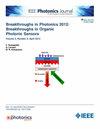基于扩频编码调制的高性价比喇曼光谱采集
IF 2.4
4区 工程技术
Q3 ENGINEERING, ELECTRICAL & ELECTRONIC
引用次数: 0
摘要
拉曼光谱是一种强大的非破坏性分析工具,广泛应用于各个领域,用于识别分子结构和反应。然而,背景噪声和荧光噪声会阻碍拉曼光谱的研究。这些噪声通常比拉曼信号更强,导致光谱解释复杂。因此,高信噪比拉曼光谱对于提高识别精度至关重要。目前,技术可以用来显着放大拉曼信号,但往往需要大量的时间或复杂的硬件。扩频技术是一种成熟的通信降噪技术。本文介绍了一种将拉曼信号与扩频码相结合的方法,以获得经济有效的高信噪比拉曼光谱。首先,通过仿真验证了扩频拉曼光谱的有效性。而扩频码的互相关特性抑制了荧光和背景噪声。其次,配置了由激光器、偏振控制器和调幅器组成的硬件环境,以验证扩频拉曼系统的可行性。将样品的实测拉曼峰与原始拉曼光谱进行比较。结果表明,扩频拉曼系统提高了白细胞介素-6和墨水样品的信噪比。时序同步和码长估计算法大大简化了工程硬件设计。仿真和实验结果都证明了扩频技术可以提高拉曼系统的信噪比。它允许拉曼分析在行业中具有成本效益的硬件中获得适当的信噪比。本文章由计算机程序翻译,如有差异,请以英文原文为准。
Cost-Effective Raman Spectra Acquisition Based on Spreading Code Modulation for Exciting Light
Raman spectroscopy is a powerful, non-destructive analytical tool that is widely used across various fields for identifying molecular structures and reactions. However, Raman spectroscopy may be hindered by background and fluorescence noises. These noises are often stronger than Raman signals, causing complicated spectral interpretation. Therefore, a high signal-to-noise ratio (SNR) Raman spectrum is crucial for better identification accuracy. Currently, techniques can be used to amplify the Raman signal significantly, but often require significant time or complex hardware. Spread spectrum is a mature technology used in communication to suppress noise. This study introduces a method combining Raman signals with spreading codes to obtain cost-effective high SNR Raman spectra. Firstly, simulations were conducted to verify the spreading Raman spectrum with efficient computation. While the fluorescence and background noises were suppressed due to the cross-correlation properties of spreading codes. Next, a hardware environment comprised of a laser, polarization controller, and amplitude modulator was configured to demonstrate the feasibility of the spread spectrum Raman system. The measured Raman peaks from the samples are compared with the original Raman spectrum. The results demonstrate that the spread spectrum Raman system improves the SNR for both interleukin-6 and ink samples. The timing synchronization and code length estimation algorithms significantly simplify hardware design for engineering. Both simulation and experimental results validate that the SNR of the Raman system can be improved by using a spread spectrum technique. It allows Raman analysis for appropriate SNR with cost-effective hardware in the industry.
求助全文
通过发布文献求助,成功后即可免费获取论文全文。
去求助
来源期刊

IEEE Photonics Journal
ENGINEERING, ELECTRICAL & ELECTRONIC-OPTICS
CiteScore
4.50
自引率
8.30%
发文量
489
审稿时长
1.4 months
期刊介绍:
Breakthroughs in the generation of light and in its control and utilization have given rise to the field of Photonics, a rapidly expanding area of science and technology with major technological and economic impact. Photonics integrates quantum electronics and optics to accelerate progress in the generation of novel photon sources and in their utilization in emerging applications at the micro and nano scales spanning from the far-infrared/THz to the x-ray region of the electromagnetic spectrum. IEEE Photonics Journal is an online-only journal dedicated to the rapid disclosure of top-quality peer-reviewed research at the forefront of all areas of photonics. Contributions addressing issues ranging from fundamental understanding to emerging technologies and applications are within the scope of the Journal. The Journal includes topics in: Photon sources from far infrared to X-rays, Photonics materials and engineered photonic structures, Integrated optics and optoelectronic, Ultrafast, attosecond, high field and short wavelength photonics, Biophotonics, including DNA photonics, Nanophotonics, Magnetophotonics, Fundamentals of light propagation and interaction; nonlinear effects, Optical data storage, Fiber optics and optical communications devices, systems, and technologies, Micro Opto Electro Mechanical Systems (MOEMS), Microwave photonics, Optical Sensors.
 求助内容:
求助内容: 应助结果提醒方式:
应助结果提醒方式:


